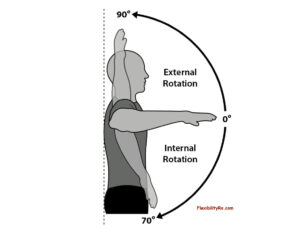Next stop, external rotation station!! Toot, toot Bould Movers!
Strength Through Range
Boulderers need the muscles surrounding their shoulders to be strong through their full range of motion moreso than their moving buddies that attend commercial gyms.
Each reach and pull/push loads the shoulder at a different angle. Each angle means a different part of the shoulder is being worked harder than others. So in order to be the best boulderer you can be, you best be strong in multiple shoulder movements and positions.
Brief Anatomy
If you consider the muscles surrounding the shoulders as either: extensors, flexors, external rotators and internal rotators for the remainder of the article it will help with my explaining and your visualising. Note: the shoulder is a ball and socket joint, capable of many movements.
Image 1. The movement of shoulder flexion is produced by the shoulder flexor muscles. Same goes for extension and extensor muscles.

Image 2. The movement of shoulder external rotation is produced by the shoulder external rotator muscles. Same goes for internal rotation and internal rotator muscles.

The predominant muscles used in bouldering are the extensors and internal rotators.
Overuse and Imbalances
This pattern of use can lead to muscle imbalances between the flexors & extensors and the internal & external rotators. Muscle imbalances at the shoulder have long been suggested as contributors to injury and plateauing of performance. This highlights that, too much of a good thing is never a good thing.
too much of a good thing is never a good thing.
So, in order to boulder to your best potential and reduce your risk of injury, you best be strong in all muscles surrounding the shoulder, and better yet, be strong through the entire range of these muscles.
Quick Q & A
I do yoga and already have full range. Do I still need this?
Yes, maybe moreso.
A common accessory training tool of the boulderer is yoga. Which is well-known for its potential effects on improving flexibility.
Flexibility – passive range of motion available.
It’s great having a joint capable of full range of motion, however, if you do not have the necessary muscular strength to support the joint in all of the ranges of motion that bouldering demands, then do you deserve full range of motion?
do you deserve full range of motion?
We’ll discuss this further in our next blog – Why yoga and bouldering don’t mix?
Enter, Mobility Training
Mobility – active range of motion available.
For power sports like bouldering, having strength through range is far more important than just having range.
strength through range is far more important than just having range.
Boulderers hoping to prevent injuries and improve their bouldering should invest their time into strengthening the muscles surrounding the shoulder regularly (at least weekly; twice weekly may get results sooner).
How?
The following are excellent bang for buck movements for strengthening the shoulder flexors, extensors and external rotators through their full range:
Movement 1 – Broomstick or resistance band dislocates (both are good, alternate as you wish) – 1 set x 15 reps as a warmup.
Movement 2 – Loaded windscreen wiper in supine – weighted as able – 3 x 5 – 90sec rest btw
Movement 3 – Loaded windscreen wiper in supine – weighted as able – 3 x 5 – 90sec rest btw
Movement 4 – Dumbbell external rotation – 3 x 5.
Movement 1 notes: Make the movement more ‘effortless’ each repetition. Breathe. Understand why the tight bits are tight, explore them, don’t power through them.
Movement 4 notes:
Eccentric phase – unassisted.
Concentric phase – assisted by supporting hand, especially at end range.
When the shoulder is stable enough, or the muscles are strong enough, commence concentric phase from end range unassisted.
When able to achieve 3 sets x 5 repetitions of eccentric and concentric phases unassisted, add more weight, so that assistance is again required at end range for the concentric phase.
Focus Points:
Aim for a weight heavy enough that the 5 reps are achieved ‘perfectly’ but if you tried for 7 it would start to get ‘messy’.
The shoulder is a ball and socket joint, capable of smooth, rotational movement. Aim to make the movement occur at the shoulder only for as long as you are able (before allowing ‘overflow’ into the trunk/ribs/spine).
Avoid using momentum or powerful movements to get past the more difficult ranges / places where you’re weakest.
If you’re struggling, reduce the weight.
Note:
Keep the load low – The intention of the movements are to learn control through the FULL RANGE of the muscles. So make sure the weight suits your weakest part of range.
The movements have been chosen to improve strength through range, not power or strength through part range, treat them that way and always be in control of the movement.
The pushing muscles of the shoulder are another group often requiring additional accessory training but we’ll save the ‘pushers’ for another day.
Enjoy discovering a bit more about your shoulders.
Sign up here for all of the latest Bould Move news.
Can’t wait to train with you all at Bould Move Sunshine Coast.
